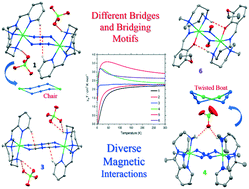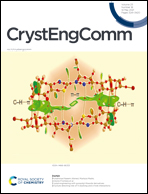Tuneable structures and magnetic properties of pseudohalo-bridged dinuclear Ni(ii) complexes derived from {N4} and {N3O} donor ligands†
Abstract
Tetradentate ligands with {N4}-donor (L1 and L2) and {N3O}-donor (HL3) groups prepared from a traditional Schiff base condensation reaction of N,N-dimethyldipropylenetriamine with pyridine-2-aldehyde or 2-acetylpyridine or 3-ethoxysalicylaldehyde, respectively, were used to react with Ni(II) salts in the presence of different pseudohalide ions, resulting in six new Ni(II) dimers with different bridging modes: [Ni2(L1)2(μ1,3-N3)2](ClO4)2 (1), [Ni2(L1)2(μ1,3-NCO)2](ClO4)2 (2), [Ni2(L1)2{μ1,5-N(CN)2}2](ClO4)2 (3), [Ni2(L2)2(μ1,3-N3)2](ClO4)2 (4), [Ni2(L3)2(μ1,1-N3)2]·0.5MeCN (5) and [Ni2(L3)2(μ1,1-NCO)2]·0.5MeCN (6). Their structures and magnetic properties have been studied and discussed. Double end-to-end (EE) and end-on (EO) bridging modes were observed for both the azide and cyanate ions in these complexes. While the EE or EO azido-bridged Ni(II) compounds are quite common, the doubly EE or EO cyanato-bridged dimeric Ni(II) complex 2 was quite rare. Furthermore, we observed that in complex 4, the double azido bridges cross each other to form a rarely observed twisted boat-type arrangement of the {Ni(μ1,3-N3)2Ni} core, which leads to ferromagnetic interaction through the EE azide bridges. According to the present results, the introduction of different bridges and bridging motifs affords overall diverse magnetic interactions in these Ni(II) dimers, which has been discussed and rationalized in terms of previous literature reports.

- This article is part of the themed collection: Coordination Networks


 Please wait while we load your content...
Please wait while we load your content...